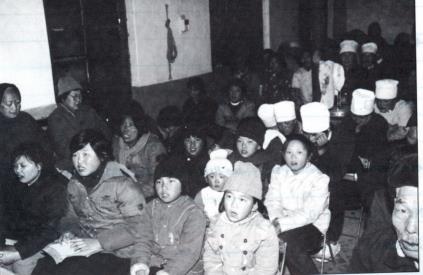
I was quite surprised when the State Council Information Office (SCIO) and the Ministry of Justice (MOJ) agreed to the proposal I made at our January 1995 meeting to accept four lists of prisoners during the year, one each quarter. I had prepared and handed over a list of 25 prisoners, leaving three more lists of 25 names to be submitted in 1995.
This was four years before Dui Hua existed, and long before the foundation had set up its political prisoner database (PPDB). Since the early 2000s, I have relied on the PPDB to draft prisoner lists, but in the 1990s I had to rely on conversations with political activists, family members of political prisoners, and NGO publications to identify names for my lists.
Among the names I included on my lists was Zheng Yunsu, leader of a Jesus Family congregation in Shandong Province who was detained in May 1992 and subsequently sentenced in September 1992 to 12 years in prison for disturbing the social order and fraud. I found his name and accounts of his detention and sentencing in Detained in China and Tibet, published by Human Rights Watch in February 1994, and The Imprisonment and Harassment of Jesus Family Members in Shandong Province, published by Amnesty International in October 1994. I placed Zheng Yunsu’s name on my fourth quarter list, which I faxed to the Ministry of Justice in November 1995.
Subsequent to Zheng’s detention, Chinese police moved in and detained dozens of other Jesus Family members, including Zheng’s four sons, and demolished their church buildings in Duoyiguo Village in Shandong Province. The arrests and destruction of church properties were eerily reminiscent of the attack by Chinese police on Youtong Village in Hebei in April 1989. A Trappist priest, Pei Ronggui, was detained, Church property demolished, and two villagers killed in the attack. Pei was subsequently sentenced in 1991 to five years in prison for “disturbing the social order.” He was granted early release on March 31, 1993, following a brief campaign of spirited intervention with my interlocutors.
Instead of being put in prison for counterrevolution, both Pei Ronggui and Zheng Yunsu were imprisoned for disturbing the social order, a precursor of “using a cult to sabotage implementation of the law,” Article 300 of the Criminal Law amended in 1997.
The Jesus Family: A Brief History
The Jesus Family is an indigenous Christian communitarian group that emerged in Shandong Province during the 1920s. Although it was influenced by Pentecostal missionaries, the Jesus Family is not a Pentecostal church. Founded by Jing Dianying, a charismatic Christian who was raised in a traditional Confucian family that practiced Buddhism and who later attended a Methodist high school, the Jesus Family expanded rapidly throughout China, surviving and even thriving during the Japanese occupation and the Chinese civil war that resulted in the defeat of Nationalist forces in 1949.
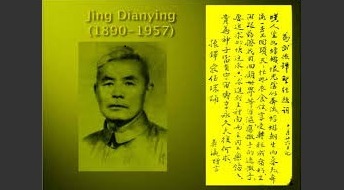
The Jesus Family emphasized simple living, poverty, communal sharing, piety, and prophesy. It emphasized prayers and singing of psalms. It reportedly rose to more than 125 congregations and 20,000 members in China by 1949. Although concentrated in Shandong, families existed in many other provinces.
After 1949, the Jesus Family leadership embraced the officially sanctioned Three-Self Movement, and for a while its activities were condoned, even praised by the Chinese government and communist party. However, the sect’s rapid growth and communitarianism came to be seen as a threat to the party, and in 1952 Jing was arrested and sentenced to prison where he developed cancer. Jesus Family properties were destroyed and the 500 members who lived in Mazhuang were dispersed throughout Shandong.
Jing died shortly after being granted medical parole in 1957. The Cultural Revolution (1966-1976) saw this unorthodox Christian group largely disappear. It was only after the reform and opening period began in 1979 that the church reemerged. It spread rapidly. In Ding’s home village, Mazhuang, the family reoccupied 43 acres of land, established a church, and grew crops. Eventually an eye hospital was established. It still serves the Mazhuang and surrounding communities and is deeply appreciated by both local residents and the party.
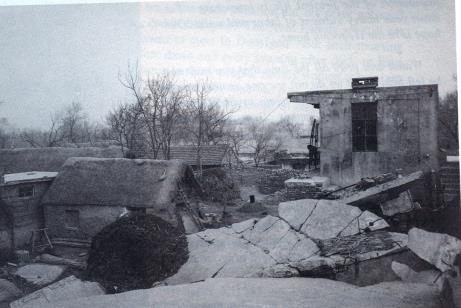
One of the biggest areas of growth took place in Duoyigao, a village near Weixian City in western Shandong. There and in surrounding villages, the family, under the leadership of Zheng Yunsu, counted around 3,000 congregants. Services, including baptisms, were attended by more than 1,000 believers. The congregation supported itself by raising rabbits, making shoes, and growing crops for its own consumption and to give away to those in need. Family activities alarmed local security forces, which subjected the group to surveillance, including using a helicopter to monitor gatherings. Members faced harassment and short detentions.
Attacks on Duoyigao Village, May-June 1992
On May 19, 1992, police disrupted a service led by Zheng Yunsu in Liuzhuang Village, a community with many Jesus Family congregants not far from Duoyigao Village. Zheng was spirited away from the service before police could take him into custody, but the next day, Zheng surrendered to police in Shandong’s provincial capital, Jinan. Not long afterwards, Zheng’s four sons were taken into custody. Zheng and his sons were paraded through Duoyigao Village and surrounding villages with placards hung around their necks identifying them as Jesus Family believers.
On June 18, 1992, 40 truckloads of police descended on Duoyigao Village. Several buildings were destroyed, and possessions – including bicycles, machinery for making shoes, furniture, bedding, clothing, livestock, and grains – were seized. On June 20, 1992, the police returned and detained more than 20 Jesus Family members. On July 10, 1992, another ten members were detained.


On October 10, 1992, Zheng Yunsu was convicted of fraud and disrupting social order by the Weishan District Court. He was sentenced to 12 years in prison and placed in Shandong Number One Prison. His four sons were sentenced to three-year terms of re-education through labor. Most other Jesus Family detainees were released after they confessed their crimes and agreed to stop their religious activities. Those released, and other members of the Jesus Family, wrote a detailed account of what they had gone through. This was provided to Amnesty International in London which published an urgent appeal based on this information in August 1993. This appeal formed the basis of the information published by Human Rights Watch in 1994, which in turn led to my including Zheng Yunsu’s name on my November 1995 list submitted to the SCIO and the MOJ.
Nine months after I submitted the November 1995 list with Zheng Yunsu’s name on it, he was granted an 18-month sentence reduction. Further advocacy resulted in Zheng Yunsu being released on parole on May 26, 1999, seven years into his 12-year sentence.
Strategy to Free Zheng Yunsu
I adopted a multi-pronged strategy for advocating on Zheng Yunsu’s behalf. I placed him on my lists and raised his name in conversations with Chinese officials from the Ministry of Foreign Affairs, the SCIO, the MOJ, and the Religious Affairs Bureau. I also put his name on lists of countries having bilateral human rights dialogues with China, notably the United States. I encouraged members of Congress to reference Zheng in their letters Chinese leaders. Finally, I used the visits of senior American religious leaders to China to raise Zheng’s name.
Following the November 1995 list on which I put Zheng’s name, I placed Zheng’s name on a list of 24 prisoners submitted to the MOJ in October 1997, immediately prior to President Jiang Zemin’s state visit to the United States, and on a July 1998 list of religious prisoners eligible for parole (they had completed half of their sentences). I gave this list to the Department of State for use in its January 1999 bilateral human rights dialogue with China.
In addition to referring to the November 1995 list that included Zheng’s name in Congress members’ letters to the Chinese government urging a resumption of the Prisoner Information Project, several members either attached their own lists of religious prisoners on which Zheng’s name was included or raised Zheng in their conversations with Chinese officials in the United States or China.
During the October 1997 state visit of Jiang Zemin to the United States, Jiang Zemin and President Clinton struck an agreement that a group of American religious leaders would be invited to visit China in early 1998.
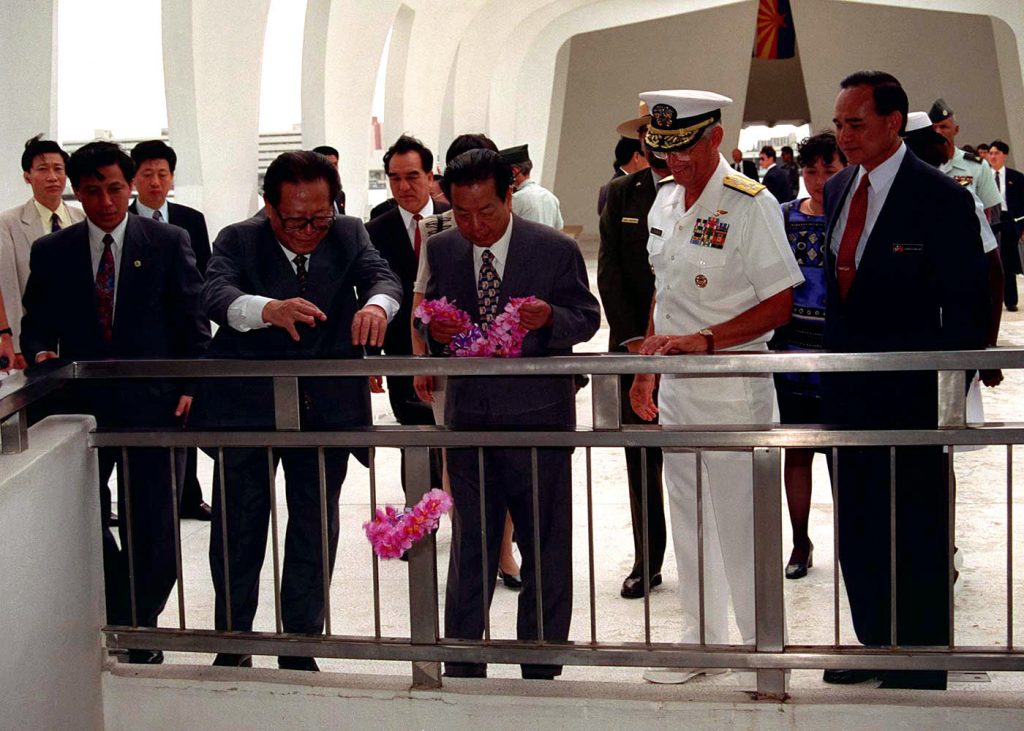
The group, led by Rabbi Arthur Schneier, president of the Appeal of Conscience Foundation, and including the Roman Catholic Archbishop of Newark Theodore McCarrick and the president of the National Association of Evangelicals Reverend Don Argue, spent two weeks in China in February 1998. They met with President Jiang in the Great Hall of the People; Rabbi Schneier presented President Jiang with a gold-embossed Torah. They also met with Ye Xiaowen, director of the Religious Affairs Bureau. They provided Ye with a list of 30 religious prisoners drawn up in consultation with the United States government and human rights activists, including me. Ye promised to give answers.
In January 1999, Rabbi Yechiel Eckstein, one of America’s preeminent rabbis, traveled to China to lobby the Chinese government to release imprisoned Christian pastors. He forcefully took up the cause of Zheng Yunsu in discussions with Director Ye Xiaowen. Four months after the rabbi’s visit, Zheng Yunsu was paroled.
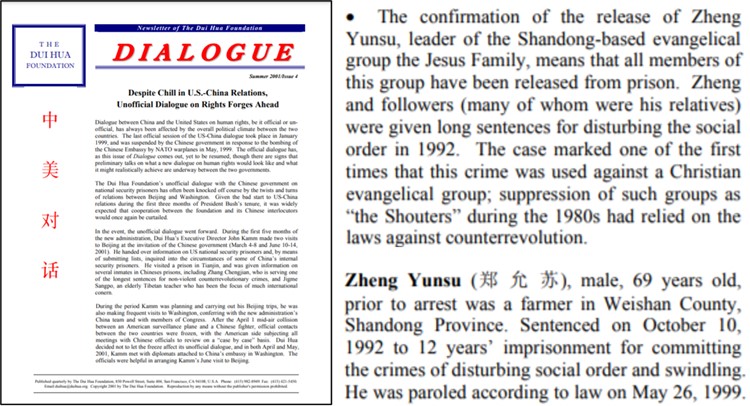
Aftermath
Little has been written about what happened to the Jesus Family after 1997. What has been written suggests that the Jesus Family has largely disappeared – disbanded, marginalized, affiliated with various house churches, or absorbed into the government-approved Three-Self Movement. In his book Pentecostals in China, published in September 2015, Robert Menzies maintains that the Jesus Family exists in non-communitarian form in various parts of China. “It’s quite small,” he writes.
An American religious scholar living in Hong Kong disagrees. This man, who visited the Mazhuang eye hospital in the early 1990s and has stayed in touch with the faith community in Shandong, states that the Jesus Family remains active in the public space. According to his account, as of the end of 2019, the Jesus Family enjoys good relations with the Three-Self Movement’s Shandong Christian Council. Zheng Yunsu, now in his late 80’s, was in good health and continuing his work. He was not in trouble with the Chinese government. He was well and at peace. His faith had set him free.
